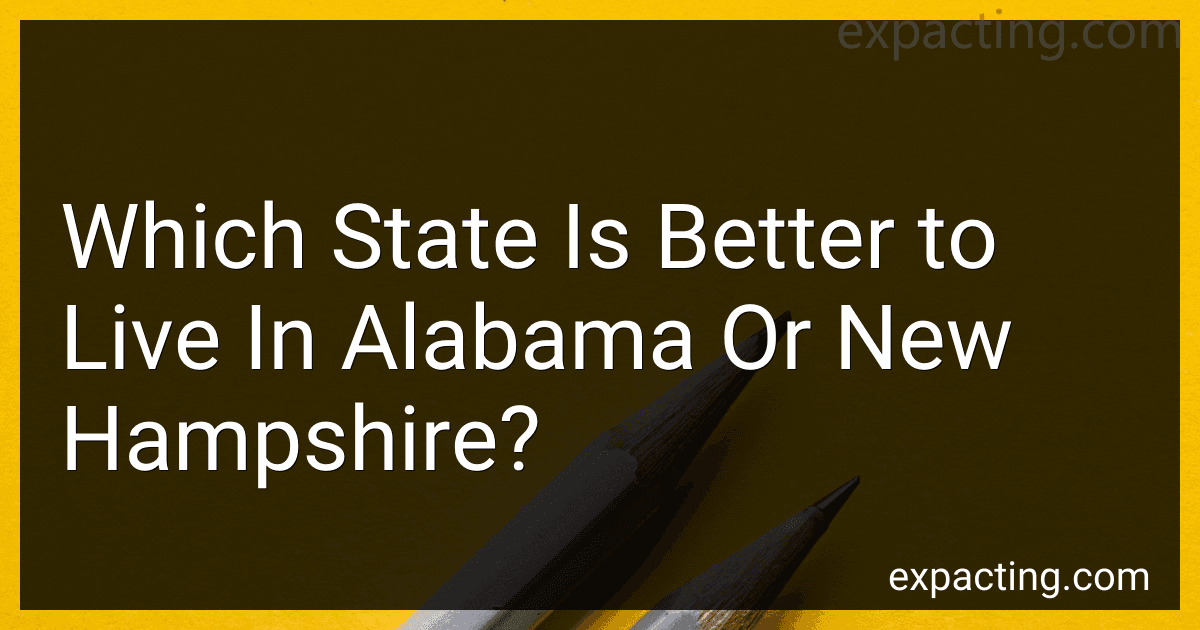Best States to Consider to Buy in January 2026

The Relocation Guide : A stress free guide helping people relocate to a new city or state.



The Ultimate Greenville Relocation Guide



Florida Bound: The Ultimate Guide to Moving, Living, and Exploring the Sunshine State



Strategic Relocation, North American Guide to Safe Places, Fourth Edition



New York Relocation Quick Start Guide



Living in San Diego: Everything you Need to Know & Full Relocation Guide


When comparing Alabama and New Hampshire as states to live in, there are several factors to consider. These include climate, cost of living, economy, education, healthcare, and recreational opportunities.
Alabama, located in the southeastern part of the United States, has a subtropical climate with hot summers and mild winters. This may appeal to individuals who enjoy warmer weather. However, the state is prone to severe weather, including hurricanes and tornadoes.
New Hampshire, on the other hand, experiences a humid continental climate, characterized by cold winters and warm summers. If you prefer distinct seasons and outdoor activities like skiing or hiking, New Hampshire might be more appealing in terms of climate.
Regarding the cost of living, Alabama generally has a lower cost of housing, transportation, and healthcare compared to the national average. New Hampshire, on the other hand, has a higher cost of living with more expensive housing and taxes.
When it comes to the economy, Alabama has a diverse mix of industries, including manufacturing, agriculture, aerospace, and healthcare. The state is home to several major companies and offers employment opportunities in various sectors. New Hampshire's economy relies heavily on sectors such as healthcare, education, tourism, and technology. It has a higher median household income but a lower poverty rate than Alabama.
In terms of education, both states have reputable colleges and universities. Alabama has several public universities, including the University of Alabama and Auburn University, as well as numerous community colleges. New Hampshire is known for institutions like Dartmouth College and the University of New Hampshire.
In healthcare, Alabama faces challenges with accessibility and quality of care. It has a higher uninsured rate compared to the national average. On the other hand, New Hampshire generally has better healthcare access and quality, with lower uninsured rates.
In terms of recreational opportunities, Alabama boasts a diverse landscape with beautiful beaches along the Gulf Coast, mountains, and forests. The state has ample opportunities for outdoor activities like fishing, boating, and hiking. New Hampshire is renowned for its picturesque landscapes, mountains (including the White Mountains), and outdoor activities such as skiing, hiking, and camping.
Ultimately, the better state to live in, whether Alabama or New Hampshire, depends on individual preferences. Factors such as climate, cost of living, economy, education, healthcare, and recreational activities should all be taken into consideration when making such a decision.
How to evaluate the job security and stability in Alabama versus New Hampshire?
To evaluate job security and stability between Alabama and New Hampshire, you can consider several key factors. Here are some aspects to compare:
- Unemployment rates: Look at the current unemployment rates in both states. Lower rates indicate better job security and stability.
- Economic growth: Examine the overall economic growth of each state. Higher economic growth often translates into increased job opportunities and stability.
- Industry diversification: Consider the diversity of industries in each state. States with a wide range of industries are generally more resilient and offer better job stability, as they are not heavily reliant on a single sector.
- Government policies and regulations: Research the policies and regulations in place that support job growth, business development, and workforce protection. Pro-business policies and supportive government initiatives can contribute to job stability.
- Major employers: Take note of the major employers in each state. Identify whether they are stable, growing, or facing any challenges. Dependence on a few large companies can increase risk, as a downturn in those sectors may significantly impact job security.
- Education and skills: Evaluate the educational infrastructure and availability of specialized training programs in both states. A well-educated and skilled workforce is crucial for attracting and retaining businesses, leading to higher job security and stability.
- Cost of living: Compare the cost of living in Alabama and New Hampshire. Areas with a lower cost of living may attract more businesses and job opportunities, providing better job security in the long term.
- Regional and national trends: Understand the broader regional and national economic trends affecting both states. This includes overall economic conditions and emerging sectors that can impact job security and stability.
By considering these factors and conducting research through government websites, economic reports, industry analyses, and local news sources, you can make an informed assessment of job security and stability in Alabama and New Hampshire.
How to assess the job market in specific industries in Alabama and New Hampshire?
Assessing the job market in specific industries in Alabama and New Hampshire can be done by following these steps:
- Research industry reports and market analysis: Look for reports, studies, and analysis specifically focused on the industries you are interested in. These reports can provide valuable insights into the current market conditions, growth prospects, and trends in Alabama and New Hampshire.
- Check government sources and labor market statistics: Visit the official websites of the Alabama and New Hampshire state governments, as well as their respective labor departments. These sources often provide data on employment rates, job growth, major employers, and other relevant information about specific industries.
- Explore local chamber of commerce websites: Chambers of commerce are great resources for understanding the business environment and economic development in specific regions. Visit the websites of the Alabama and New Hampshire chambers of commerce to find industry-specific data, initiatives, and business directories.
- Network with professionals and industry insiders: Attend industry conferences, job fairs, and networking events related to the specific industries you are interested in. Engage with professionals and industry insiders to gain firsthand information about the job market, major employers, and potential opportunities.
- Connect with academic institutions: Reach out to universities, colleges, and trade schools in Alabama and New Hampshire that have programs related to the industries you are interested in. These institutions often have career services departments with valuable industry connections and may provide insights into the local job market.
- Utilize job search portals and online platforms: Explore job search portals like Indeed, LinkedIn, or industry-specific platforms. These platforms often provide filter options to search for jobs within specific industries in particular locations. Analyze the number of job postings, the skills required, and qualification criteria to gauge the demand in the job market.
- Engage with industry associations and professional groups: Join industry associations and professional groups related to the industries you are interested in. Attend their meetings, workshops, and webinars to connect with professionals and gain insights into the job market dynamics specific to Alabama and New Hampshire.
By compiling information from these sources, you will be able to assess the job market in specific industries in Alabama and New Hampshire and make informed decisions regarding job opportunities, growth prospects, and potential challenges.
What is the diversity and inclusivity like in Alabama versus New Hampshire?
The diversity and inclusivity in Alabama and New Hampshire can differ in several aspects.
Alabama:
- Diversity: Alabama has a population that is primarily composed of White (69%) and African American (27%) individuals, with smaller populations of Hispanic, Asian, and other ethnic groups. Compared to New Hampshire, Alabama has a higher concentration of African American residents.
- Socioeconomic Diversity: Alabama has a higher poverty rate compared to New Hampshire, which may indicate a wider socioeconomic diversity with some areas experiencing more significant economic challenges.
- Political Climate: Alabama is considered a more conservative state politically, which can influence the inclusion and acceptance of certain groups, particularly those with progressive viewpoints or identities.
- LGBTQ+ Rights: Historically, Alabama has been less progressive in terms of LGBTQ+ rights compared to some other states. However, attitudes and policies have begun to evolve in recent years.
- Religious Diversity: Alabama, similar to many Southern states, has a significant Christian majority, with a smaller representation of other religious groups.
New Hampshire:
- Diversity: New Hampshire has a population primarily composed of White residents (91%), with smaller populations of Hispanic, Asian, and African American individuals. However, New Hampshire has a lower percentage of African American residents compared to Alabama.
- Socioeconomic Diversity: New Hampshire generally has a higher median income and lower poverty rates compared to Alabama, suggesting a narrower range of socioeconomic diversity.
- Political Climate: New Hampshire is known for its political independence and swing-state status. The political climate may be more moderate in comparison to Alabama, potentially creating a more inclusive environment for diverse perspectives.
- LGBTQ+ Rights: New Hampshire has been relatively progressive regarding LGBTQ+ rights, including the legalization of same-sex marriage in 2009.
- Religious Diversity: New Hampshire has a lower religious affiliation compared to Alabama, with a higher percentage of individuals identifying as religiously unaffiliated or having non-Christian denominations.
Overall, it is essential to consider that diversity and inclusivity can vary within each state, depending on specific communities, cities, or regions. This overview provides a general perspective, but experiences and perceptions might differ among individuals and specific locations within Alabama and New Hampshire.
